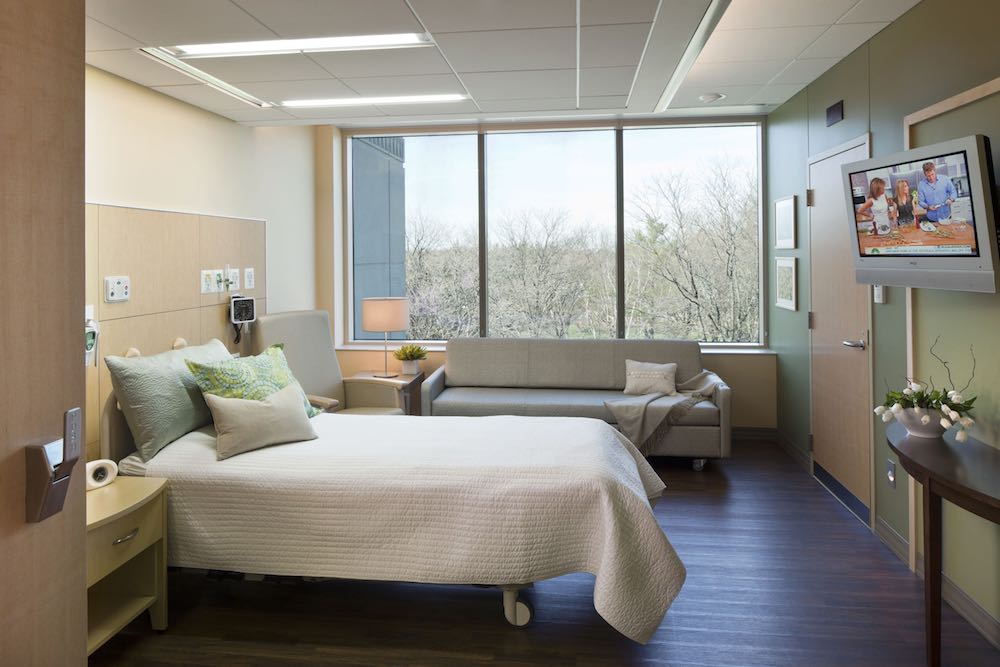
Breaking news: “Hospital ratings often depend more on nice rooms than on healthcare.”
When I saw this headline in the Washington Post two weeks ago, I was irritated. I read the article. I was still irritated.
Then I read it again and had different thoughts. Have we got this all wrong?
Can good design actually be a cover up for poor medical care?
Halo Effect of Hospitality
The article references a study of 3,000 U.S. hospitals by two Cornell University sociologists that suggests the “halo effect of hospitality” influences patients’ satisfaction more than the quality of care. The lead author of the study criticizes hospitals for competing for patients by offering private patient rooms and amenities instead of emphasizing medical outcomes.
In the abstract of the published study the authors state that, “patients are very sensitive to the ‘room and board’ aspects of care” and that quiet rooms “have a larger impact on patient satisfaction than medical quality, and communication with nurses affects satisfaction far more than the hospital-level risk of dying.”
“Hospitality experiences create a halo effect of patient goodwill, while medical excellence and patient safety do not,” they conclude.
Flaws in the Survey
Well, isn’t it obvious that it’s easier for patients to evaluate how they are treated, how good the food is, and what their surroundings look like than the clinical aspects of their care? Plus, many experts have pointed out the flaws in the multiple-choice HCHAPS survey instrument that asks patients to recall their experience — often long after it is over.
And is there something wrong with giving patients a nicer room, quieter surroundings, better food, and technology that allows them to easily access information and entertainment as well as communicate with family members? Research has shown that the design of the physical environment can help reduce stress and anxiety and help prevent things like infections and falls — all of which can lead to better health outcomes.
Quality of Medical Care Most Important
Hospitals aren’t hotels though. Never have been and never will be. The quality of medical care and patient safety is what should be most important to the patient experience.
And while the design of the physical environment may be part of the so-called “hospitality halo” that affects how patients rate their experiences, it’s essential to remember that it also supports how medical care is delivered by staff and received by patients.
Lots of healthcare providers get this. Many don’t. And it may be easier for them to improve the physical environment and add amenities than to improve the quality of medical care and patient safety.
But there is no reason they can’t do both. Only focusing on one or the other doesn’t fully address the patient experience.
What do you think?
P.S. Please do me a favor — if you liked this post and like this blog, please share it with others by sending them the link or posting it on your Twitter, LinkedIn, or Facebook. Also, don’t forget to subscribe, so you’ll get emails when new content is posted. Thanks!
Photo: Courtesy of HDR.
If you like this post, please share.

What’s my story? I’m a healthcare and senior living design knowledge expert who writes and speaks frequently about trends and issues affecting these two industries. I’m also a strategic marketing consultant and content creator, working with companies and organizations who want to improve the quality of healthcare and senior living through the design of the physical environment. You can reach me at sara@saramarberry.com.


4 Responses
I believe the design team has to do both! They have to have a quality functional state-of-the-art medical facility, while providing a pleasant healing environment. This is a challenge for the design team and should respond directly to the owner client priorities, the medical staff, the community and the patients it serves. The outcome together will provide outstanding patient care, happy medical staff, success in the community and an asset for all.
Yes, designers can create functional, pleasant environments, but if the medical staff isn’t up to snuff, then the quality of care will suffer. Clearly, as you point out, collaboration will produce better outcomes. Thanks for your comments!
Thank you Sara for calling attention to this article. Reading the article does provide a mix of emotions for all those involved with the design of healthcare facilities, but in my mind, good design in healthcare is an absolute requirement. Good design does not mean large atriums, oversized patient rooms, lavish materials, and the highest-end furniture and equipment. Good design enables healthcare providers to deliver the best care to their patients, it provides for state-of-the-art technology, it provides beautiful spaces, light, color, artwork, ease of wayfinding, and many other components to reduce anxiety and stress. It allows patients and families to have the best possible experience in a comforting and healing environment while receiving care. What is important is that representatives from the healthcare side and from the design side have open, honest, and thorough discussion throughout the design process to determine what is appropriate, what is necessary, and how great design can be a catalyst in transforming how care is provided and improved.
Well said, Jonathan! You are so right. Good design is not all the flashy stuff, which many mainstream journalists fail to understand. It is about beauty and comfort — and supporting the tasks/activities going on in the space. Thank you for your comments.